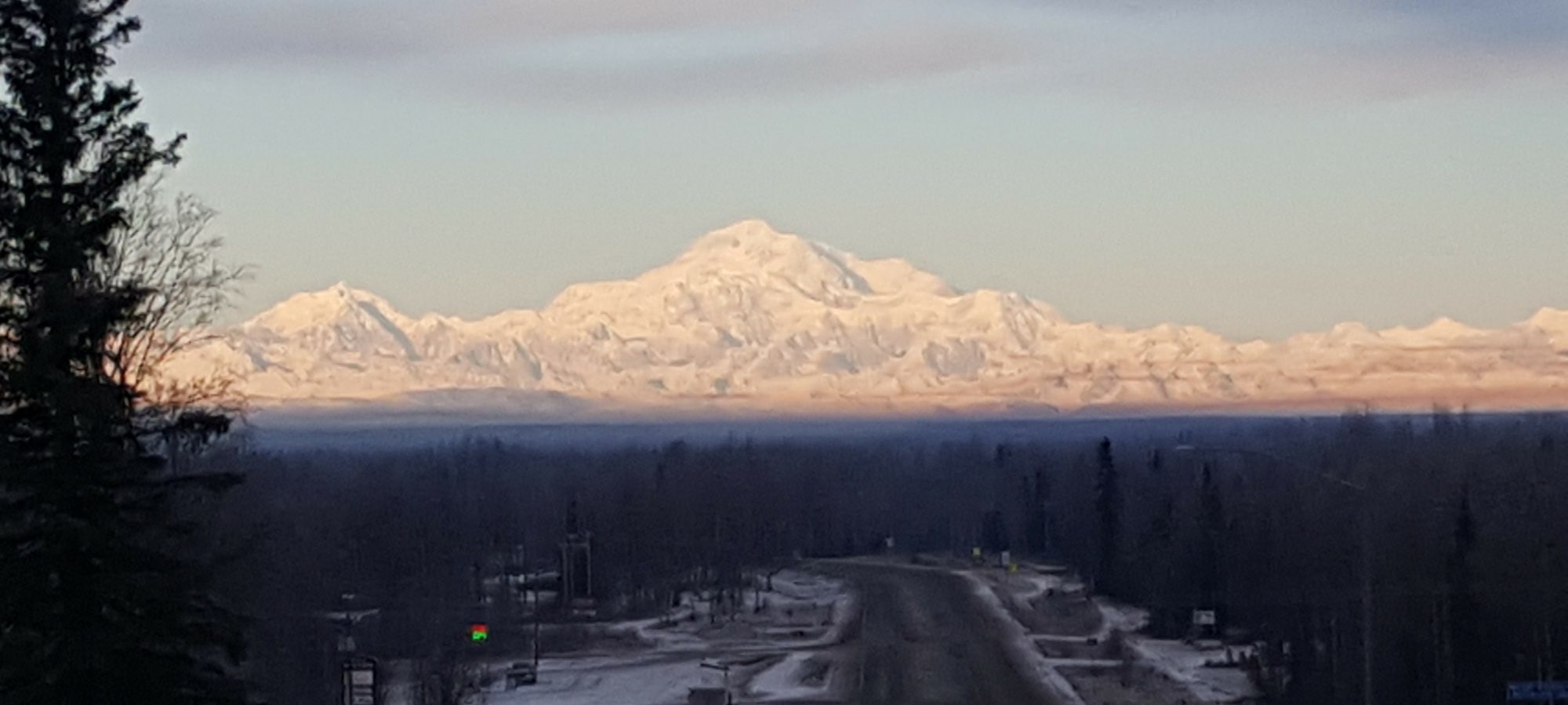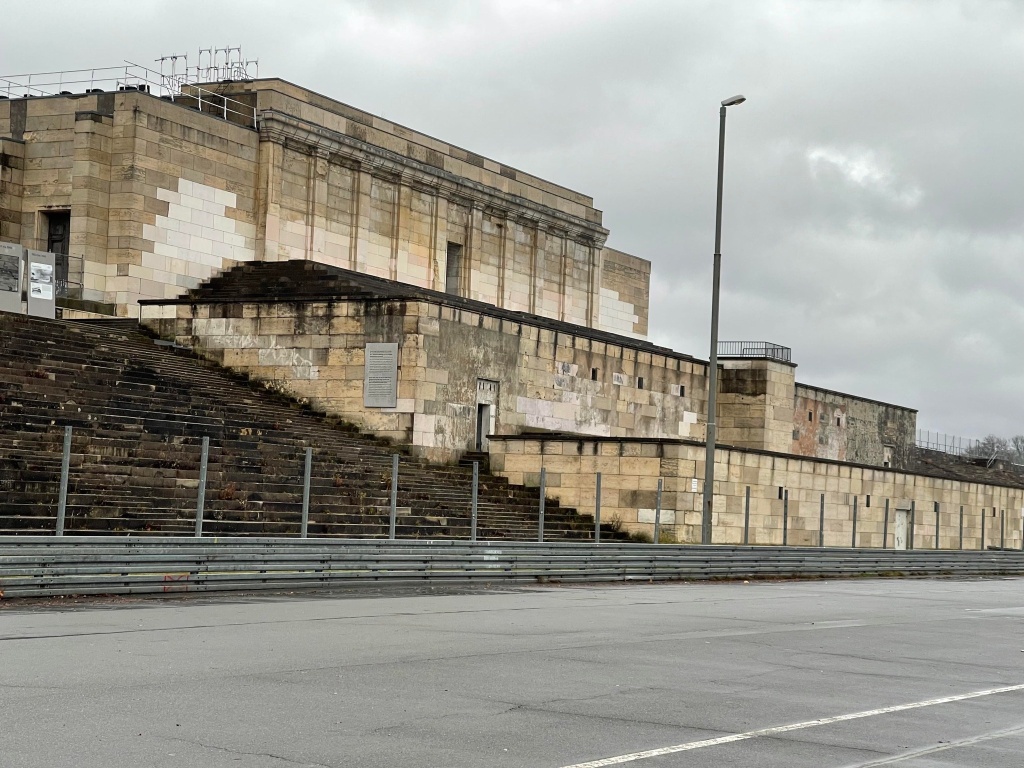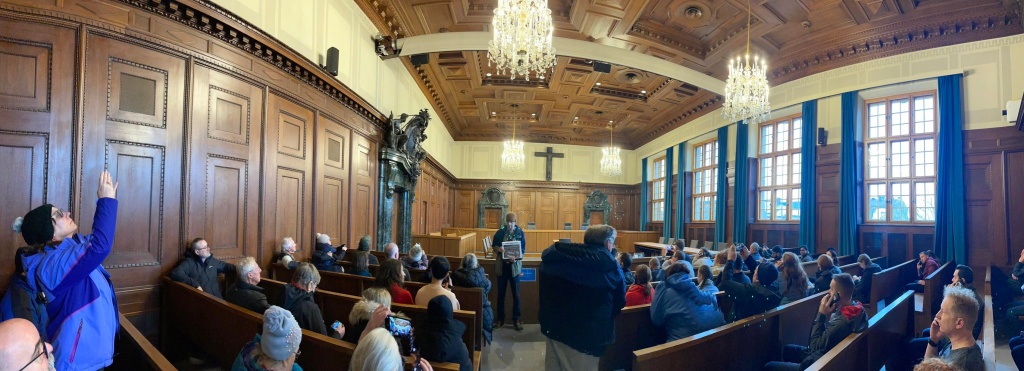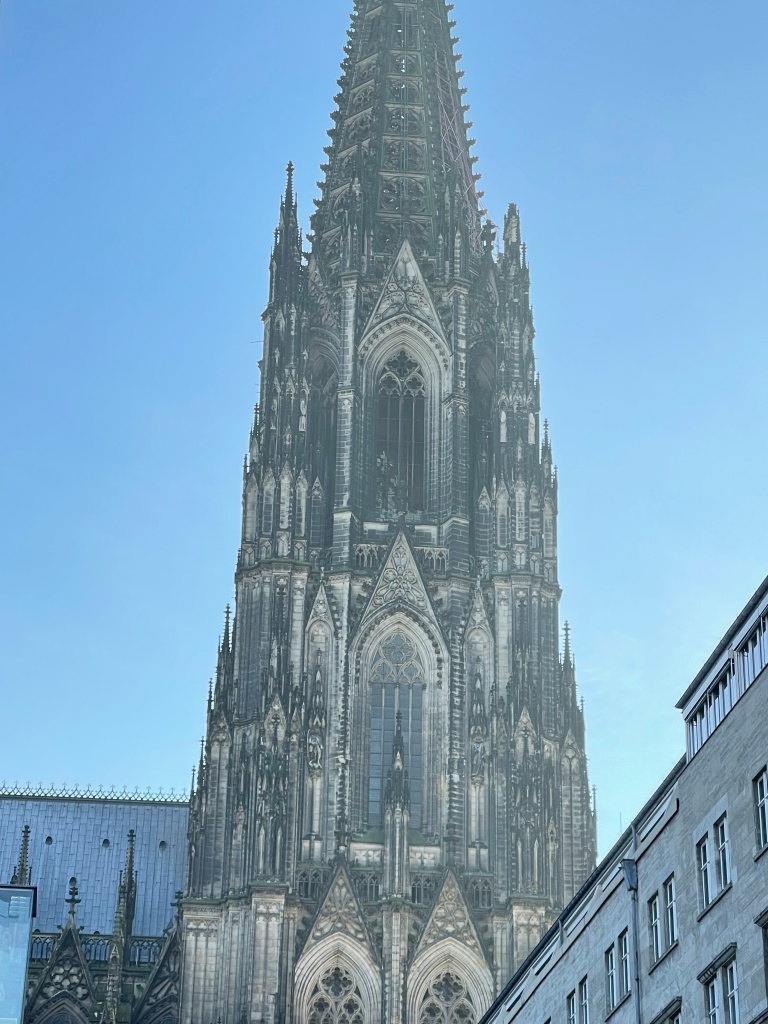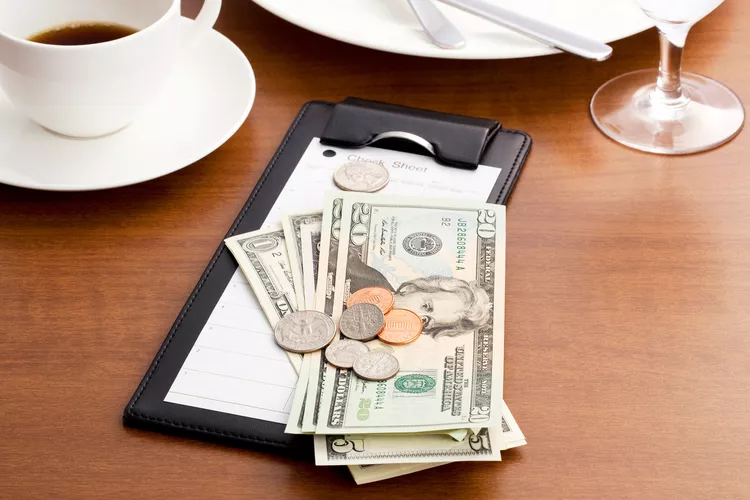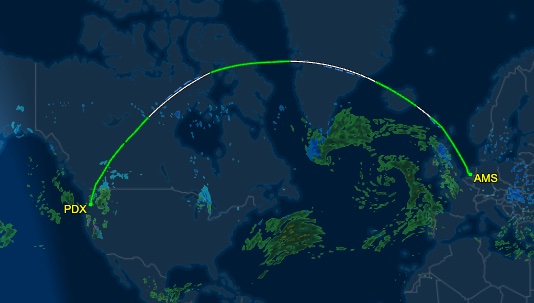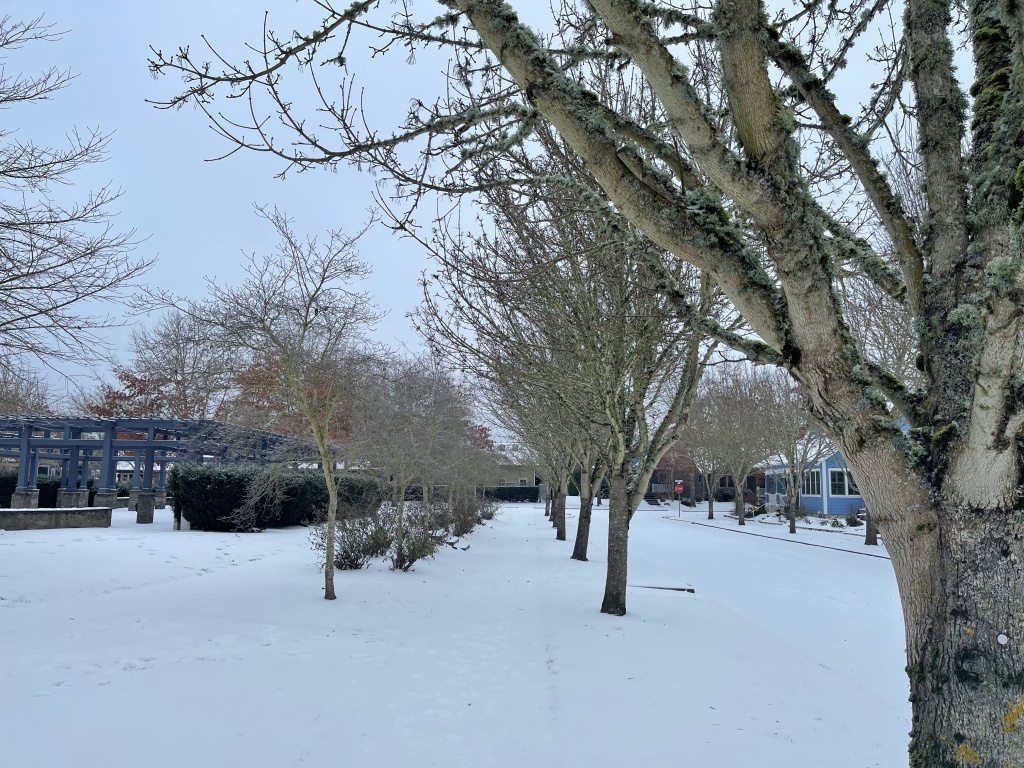
A little story about my vacation in Europe
The Viking River Cruise ships (I will delete any comments about raiding monasteries) are like miniature ocean cruise ships. They only carry 190 passengers, but the amenities are much the same. They serve gourmet breakfast, lunch, and dinner, though I stopped drinking wine and eating dessert for lunch after about the fourth day.
One morning at breakfast, we were joined by a lovely couple from Arizona, Karen and Dan. We exchanged life stories and I mentioned that I was an author.
At Dinner, Karen informed me that she had purchased the Kindle version of my book, Memory and Metaphor and was really enjoying it.
Best vacation ever!!
I can deduct the cost of the trip from my taxes now, right?
Day 14: Vienna and the Cruise Crud
Full Moon over Vienna
While riding the bus back from Salzburg to the boat, I heard several people coughing. And not just an irritated throat cough. These coughs came from deep in the chest and sounded wet.
And I didn’t have a mask. We started wearing masks after that, but it was too late. Beth was the first to get sick, and then I came down with a congested chest and a stopped-up nose last night. One of the other passengers started calling it the “Cruise Crud.” Beth is much sicker than I am, but she’s not down and out yet. I can’t sleep with these sinuses, so I’m up writing this blog post at 03:30.
Vienna has a population of almost two million people, and it feels like it. Walking downtown, it’s difficult to avoid bumping into people, and most of them aren’t watching where they’re going. And younger people will often not even attempt to avoid you, assuming that you’ll avoid them. Even though it’s the off-season, the city feels like it’s choked with tourists, Beth and I among them. I can’t even imagine what it’s like in the warm months. The city feels like San Francisco in that respect.
However it is a clean city with low crime and unemployment rates. It has enchanting architecture, is the cradle of classical music, and there are coffeehouses everywhere.
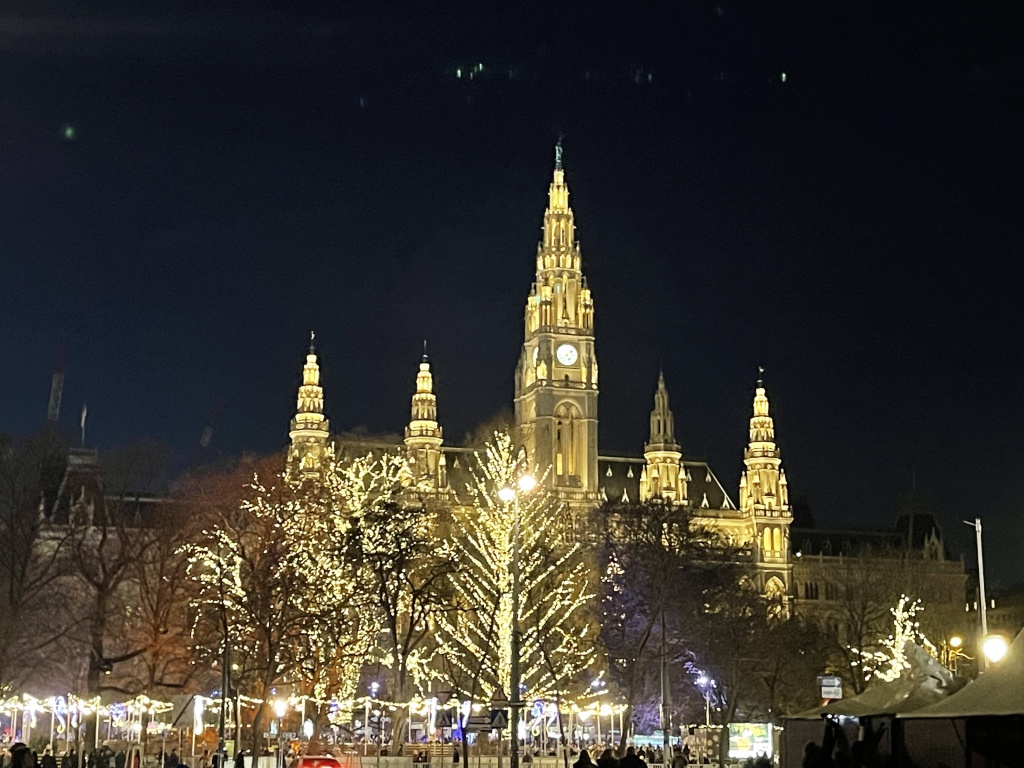
After visiting the Lipizzaner Stallions at the Spanish Riding School, we went back to the boat for dinner, then got back on the bus to hear a Mozart and Strauss symphony. We never saw it, though, as there was some major equipment failure. So we went back to the boat again and played Scrabble.
We have one more day in Vienna (mostly spent in finding a good drug store) then we’re off to Budapest.
Day 9: Nürnberg
I visited Nürnberg yesterday and it was quite sobering. We read about the Second World War and we see the movies and the documentaries, but it doesn’t compare to standing in Zeppelinfeld, the same place as Hitler and the throngs of people dedicating their lives to him in the arena where Nazi rallies were held. Touching the granite and limestone is like touching that horrible history, almost hearing the crowds proclaim their love for a single genocidal, megalomaniacal man.
It’s quite a different feeling than simply reading that Germany invaded Poland in 1939.
I also visited the courtroom where the Nürnberg trials were held after the war. The history was tangible, almost like the ghost of Göring was breathing down my neck. My parents and in-laws lived through that war, and Beth and I missed it by a decade. The temporal distance lessens the feeling of horror. For us, it was stories. For our parents, it was more than just headlines – it was the stories from the front, the news of relatives escaping a world gone mad, enlisting to fight in a war that made no sense.
But standing there, touching the stones, it hits you in the face. Do you feel the distance?
There are debates about what to do with these monuments to terror. The majority hold that should be preserved as tangible history, and I agree with them.
Day Three: Cologne (Köln)
I’m not a fan of large cities. Exhibit A: I used to live in the San Francisco Bay Area and today I live in rural Oregon. Exhibit B: In the Summer of 1976, I lived for three months in Los Angeles, and I still haven’t recovered.
As a city of 1 million residents, Cologne isn’t bad. It doesn’t smell like a big city – at least not the parts I visited. It’s clean, and it’s pretty. I still wouldn’t live there, but I don’t mind visiting. That’s not to say that Cologne doesn’t have big city problems: I was approached by three beggars while walking about.
Until today, my only use of the German language on this trip was to translate the label of a bottle of Coca-Cola, which didn’t have any high-fructose corn syrup, to the surprise of everybody sitting at the same table. And today, I failed my practical test when I asked for “Zwei heiße Schokolade, bitte” and the guy responded in English. Damnit! However, I later navigated conversations with a pharmacist (I asked for ibuprofen) and a barista (I asked for a small coffee to drink “für hier”.) without anybody getting their feelings hurt. I even told another pedestrian that, “Der Stadtbus ist dort drüben” when she asked for directions to a specific bus line.
We never left the vicinity of the cathedral, so I can’t tell you about the rest of the city. We went through two Weihnachtsmärkte but only purchased a small bag of roasted chestnuts and made a donation to an organization that is dedicated to removing trash from the Rhein. The Christmas market in the cathedral court had an unpleasant and unidentifiable smell so we didn’t stay too long. The second market was much nicer: Not as crowded, and no odor. It had a fairy tale theme.
I tried to capture this “glowing” tower on the cathedral. The light was reflecting off of the surrounding building with the sun low in the west. The undersides of the arches were brighter than the underside.
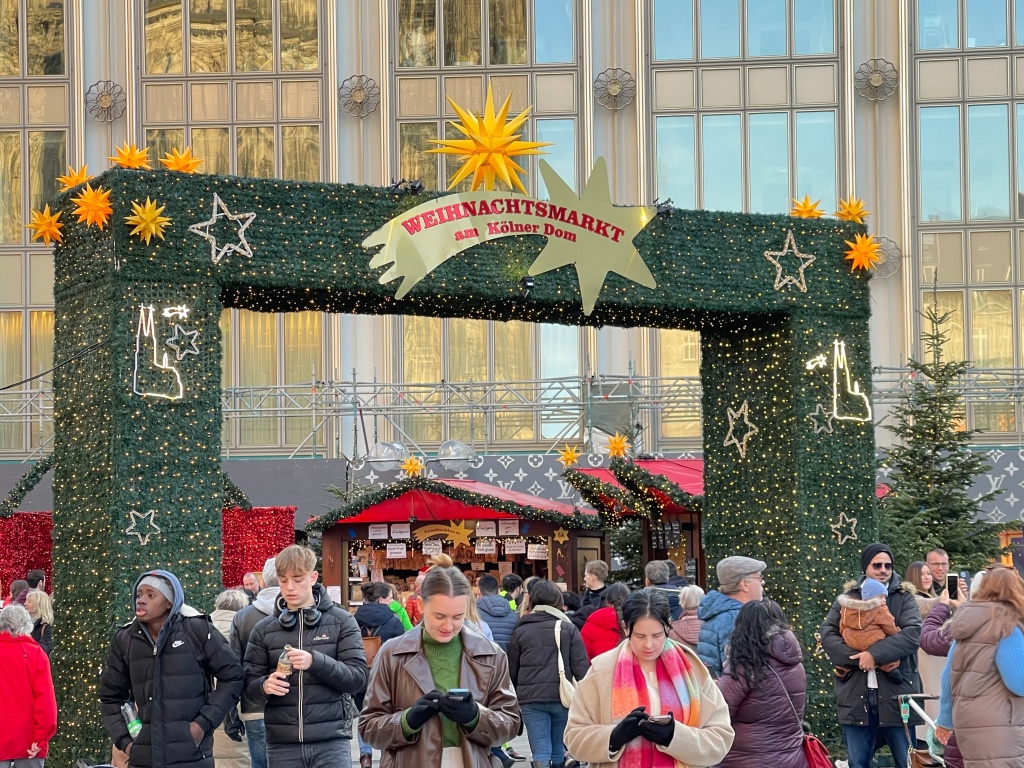

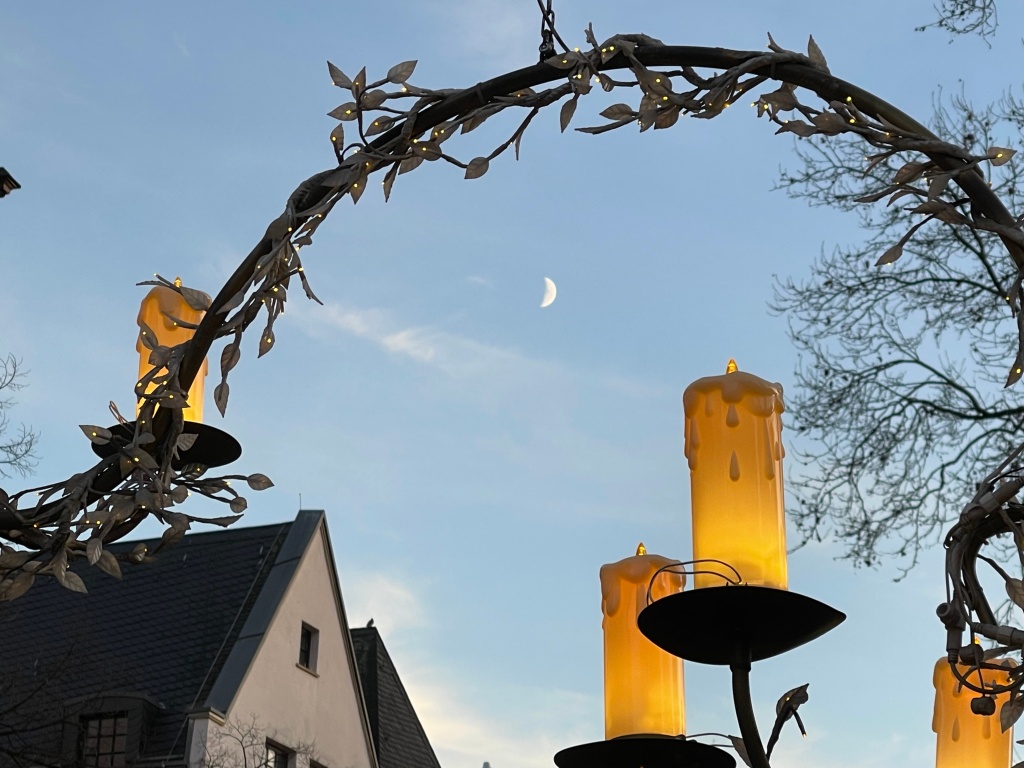
Tomorrow, Koblenz!
Day 2: Kinderdijk: It’s all about the windmills (and a water tower.)
After sailing all night, most of the passengers woke up on an overcast, blustery morning, with windchill at about 3° C (37° F) to something approximating this view. Kinderkijk is a World Heritage Site, and all 19 of the windmills, built centuries ago, still work. A tour guide told us that one may, upon conclusion of a 2-year education and passing a physically demanding test, rent one of these mills to live in and the rent is pretty cheap. He didn’t mention how long the wait list is, or if there is one.
According to the tour guide, Ukrainian refugees are living in the windmill shown below, though it can’t be very many. We saw the interior of a mill, and there’s about as much floor space as a single-bedroom apartment in the cheap part of town. They were built around 1740, and though their function has been replaced by modern pump stations, they still wor k and could be used if the modern plumbing stopped working.
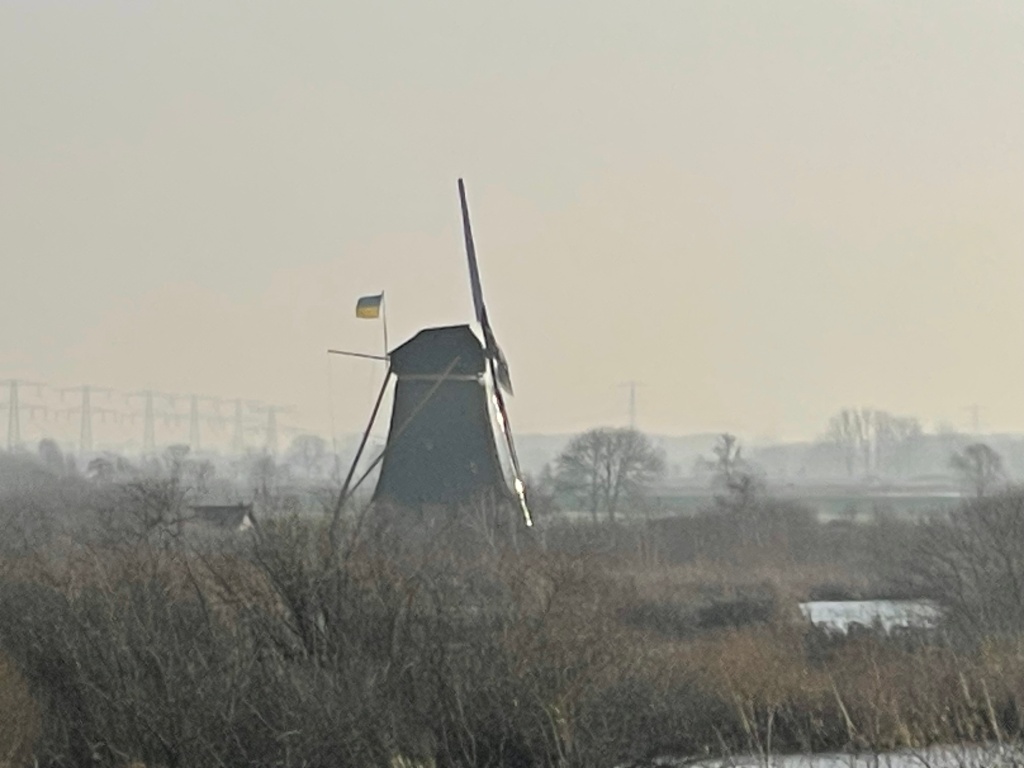
We also saw this tower, which, according to Google, is an unused water tower and a historical monument.
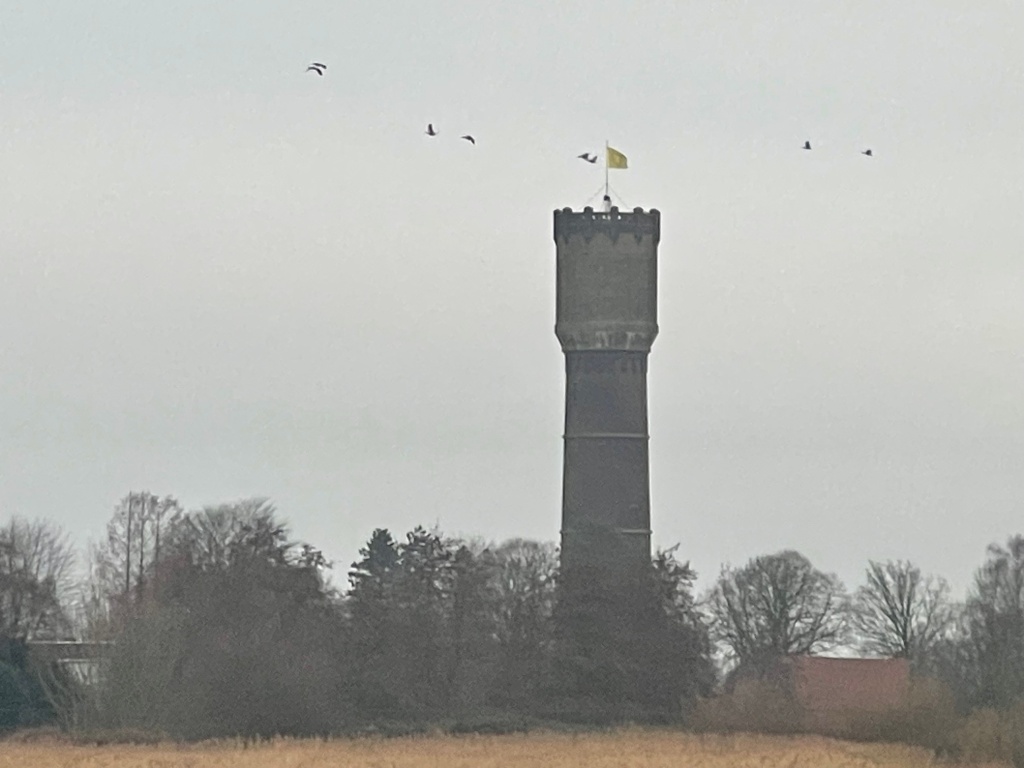
Sometimes the wildlife cooperates with the photographer. I only needed a few seconds for the geese to fly into the field of view.
Built in 1867, the water tower served as a backup to the windmills in times of high water, helping to keep the surrounding polders dry. There is a museum in the tower, but the tour guide never mentioned it, and we didn’t have time to visit it. The tower is 33 meters (109 feet) tall and 18 meters (59 ft) wide at the base.
Tomorrow we visit Cologne.
Day 1. Portland, Oregon to Amsterdam
It’s 03:30 on Sunday morning, and suffice it to say that my circadian rhythm is seriously messed up. While I’m sure that things will settle down in a day or two, it’s annoying.
We woke up at 06:30 on Friday to finish packing things like toiletries and last-minute additions to our suitcase inventory, made it to PDX by 10:00, and the plane departed right on time at 13:20.

I managed to get this photo of Mt. Hood while flying over Washington State with the iPhone. I discovered a good argument for dedicated cameras is manual focus. The iPhone wanted to focus on the window pane, and I had to do some manipulating to get it to focus on the damn mountain, and even then it was a dynamic thing, going in and out of focus. I waited until the mountain could be seen clearly before clicking the picture and it took several attempts to get this result, and I’m still not quite happy with it.
While the seats in Premium Economy weren’t uncomfortable, I could not get comfortable enough to fall asleep. We made it to Amsterdam at 07:30 local time, and I just had to take this picture of the sunrise.

The starboard engine is illuminated so brightly because the landing lights were on, and that’s what the camera wanted to focus on. Fortunately, you can set the f/stop on an iPhone, so I cranked it as far up as possible while still getting the colors of the sunrise, giving a deep field of focus. Welcome to Amsterdam!
Amsterdam airport is huge! The aircraft taxied forever. Beth joked that we were going to get a tour of the city from the Airbus 330. We taxied for at least 15 minutes. Once we disembarked, things went smoothly. We breezed through passport control, and as far as we could tell, our luggage wasn’t searched. It was a short walk to where gofers from Viking Cruise Lines wrangled us into vans to take us to the docks.
Beth rode shotgun and reported that the driver ran through at least three red lights. Maybe it was the driver, or maybe Amsterdamers consider traffic signals to be mere suggestions, like New Yorkers. We only have the one data point, so it’s impossible to tell.
We finally arrived at the riverboat Viking Bragi but our stateroom wasn’t ready for us. We grabbed sandwiches in the lounge and tried to stay awake. By this time it was 11:30 locally and 02:30 in Oregon. Our stateroom became available at noon, and though the activities director announced that a tour of the city was available, we headed straight to bed. We only woke up long enough to participate in the mandatory safety drill.
We were instructed to put on the buoyancy vests located in the room. Instead of finding them in the convenient spot which was marked with a stylized life vest, they were stowed under the bed. Not just under the bed, but in the least accessible point under the bed, so that I had to get down on my knees, and then on my stomach to reach them. I am certain that this is a test to see if any passengers have orthopedic problems. I have abused my knees sorely in my lifetime, and they told me that there were only so many attempts to get the life vests left in their repertoire. So when the drill was over, I put them back in the spot with the life vest icon. However, while we were at dinner, house cleaning came in, made our beds, and threw the live vests back under the bed.
I told you: it’s a test. Considering that the average age of the passengers on this trip is about five years older than we are, I think it might also be an attempt at population control.
Three days to go. To Tip or Not to Tip?
I have a question for all you world travelers and residents of Europe.
Viking River Cruises has advised us, as American travelers, to always tip generously when we dine at local restaurants while in Europe. However, I’ve been told time and again, and have watched YouTube videos that say, “The rest of the world thinks that the American Tip Culture is weird, and servers in Europe actually get paid enough so that they don’t rely on tips.”
My intuition tells me that Viking wants to make sure that the people in European ports stay happy that their cruise line is docking in their city. “Here comes the Americans,” the locals might say. “Expect more money!”
Does Viking advise passengers from other countries to tip well?
If Americans stopped tipping so generously in Europe, would they be less welcome?
Do international relations have to be so transactional?
I’m looking forward to your feedback in breathless anticipation.
Eurotrip and Volcanos
I noticed today that our flight from Portland, Oregon to Amsterdam in the Netherlands passes over Iceland, so I immediately checked on the status of the Fagradalsfjall volcano. According to Dr. Margaret Hartley, lecturer in Earth Sciences at the University of Manchester, the chance of a volcanic eruption is very high.
Working as an FAA Authorized Inspector in California, I remember all of the Notices to Airmen, or NOTAMs, that came out during previous eruptions. There were also a dozen or so Airworthiness Directives involving jets flying in the vicinity of a volcanic dust cloud.
According to the FAA, there are no current NOTAMs regarding the Icelandic volcano.
I don’t believe that, if Fagradalsfjall erupts, we’ll have to postpone or cancel the flight. I’m sure the airline will be able to find an alternate route.
According to the Icelandic Meteorological Office, there has been an increase in earthquakes, including larger tremors, indicating the movement of magma. There has also been some slight ground deformation in the area, which is another indication of a potential eruption.
Whether there is or is not an eruption is not anything we can do anything about, so I’m not going to worry. If there is one, we’ll deal with it.
Still, I found it an interesting coincidence.
Everybody loves maps
Three weeks and five days until we leave. Somebody will drive us to Portland, Oregon, then we’ll fly to Amsterdam and get on a boat. In the map below, I’ve coded the boat trip along four rivers in red, the flight from Budapest to Munich in Green, and the train route from Munich to Berlin in purple. There is also a small side trip from Passau to Salzburg.
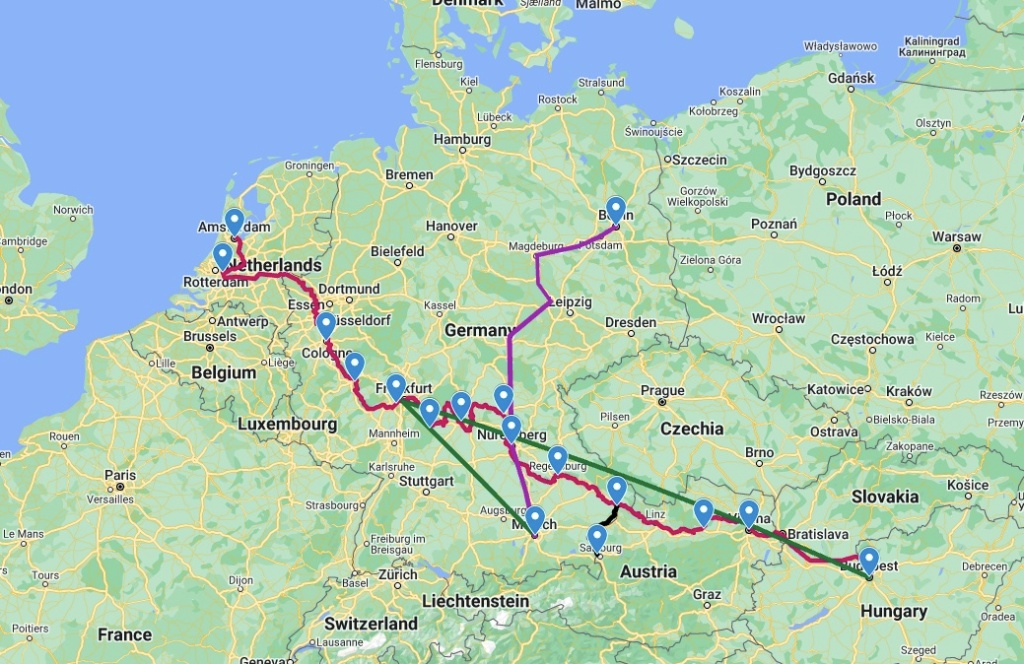
Leaving for Europe in 50 days
“Why the hell are you visiting central Europe in the dead of winter?!” is a question I get a lot these days.
Yes, most of the cool cultural stuff in Europe happens in the warmer months. Lots of festivals and so much to do when the temperature is above freezing. But that’s also why it’s cheaper to visit in the Winter. Airlines, hotels, and local businesses charge less when there isn’t a horde of tourists descending on the location. Plus, there are all the cool cultural stuff that most people don’t see.
There are also fewer crowds. We’ll be able to more fully appreciate the experience, rather than cursing the lines of people. If you’ve ever been to Disneyland, and odds are, you have, then you can understand this.
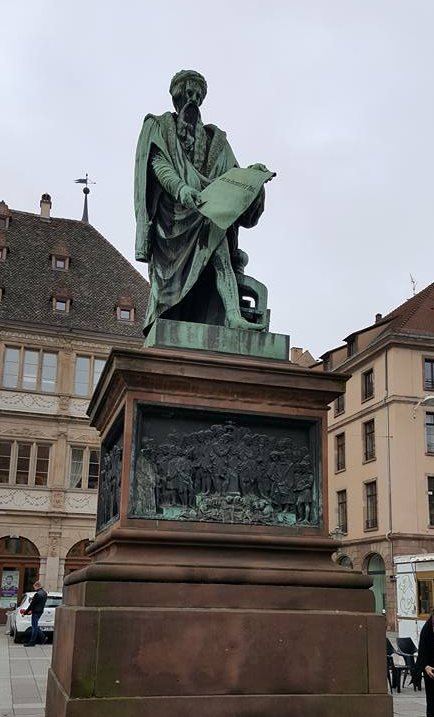
Gutenberg points out a typo.
I also believe that traveling in the off-season allows us to experience a more authentic Europe. Rather than pre-packaged tours, we can wander around, get lost, and interact with locals. We have booked some touristy things to do, like visiting the Lipizzaner stallions in Vienna, but we’re going to spend three days in Munich without planning much. We’ll be in Munich for the Silvester celebration (New Year’s Eve) and anything that happens will be totally spontaneous. Our hotel is a mere 250 meters from Marienplatz, and I don’t think we’ll be able to escape the event even if we wanted to.
I plan on walking through some of Germany’s famous Weihnachtsmärkte, including the ones the Cologne. In preparation for this, I asked Google for a map of the kölner Weihnactsmarkt, and it responded, “Here’s a list of all of them.”
“All of them? Hmm. This might be a busy day.”
I’ll be in Salzburg, Austria on December 25. Most of you know this town from The Sound of Music, but it’s also the birthplace of Mozart – and of course there’s a Mozart museum – and it’s also the location of the Stefan Zweig Center. (Feel free to google that.) Will these places be open on December 25? I’ll let you know.
There will also be opportunities to take stunning Winter photographs without a lot of people getting in the way. This point has started a conversation about whether we should take a dedicated and expensive camera, or just use the iPhone. The problem with cameras is that they are bulky and heavy, take up a lot of room in the suitcase, are prime targets of thieves, and require accessories like lenses and chargers. The iPhone is handy, small, and I’m going to take it anyway. While not as good for taking creative photographs, the iPhone camera comes with a lot of manual adjustments (I hate automatic exposures which can take all the excitement out of a photo), and I’ve been amazed at the quality of photos and videos taken with iPhones. If you have advice on this topic, please leave it in the comments.
I’m also going to buy a eSIM card so that I can have a local phone number. When we traveled to Europe in 2016, I tried to use Verizon’s services to navigate, but Google Maps said we were in Seville, Spain the entire time, though we were never in Spain. I intend to solve this with the local eSIM card. It’ll also be easier to make restaurant reservations.
I’ll be posting videos/photos (whether from the Pentax, the iPhone, or the GoPro) and stories here. Mark your calendar for December 15.
This is very exciting! Recognition from SFWA!
Last October, the Science Fiction and Fantasy Writers Association, SFWA, put out a call for submissions for a Storybundle with the tagline, “Space is Big. Really Big.” They were looking for space operas and the like. The managing editor at Water Dragon Publishing, Steven Radecki, contacted me and suggested that I submit Memory and Metaphor.
I consented, and Steven submitted it for me, along with other writers associated with his imprint. I didn’t think anything about it until this morning, Sunday, December 18, 2022, when I received another email from Steven saying that, along with 14 other stories, Memory and Metaphor had been selected!
Oh, my gosh!
I don’t want to get too far ahead of the schedule, and I’m told that things will happen in March of 2023. I will revisit this topic again then and give more details, but I felt like I had to share it with people!
Below. The universe of Memory and Metaphor. Yes, space is big. Scale is in lightyears.
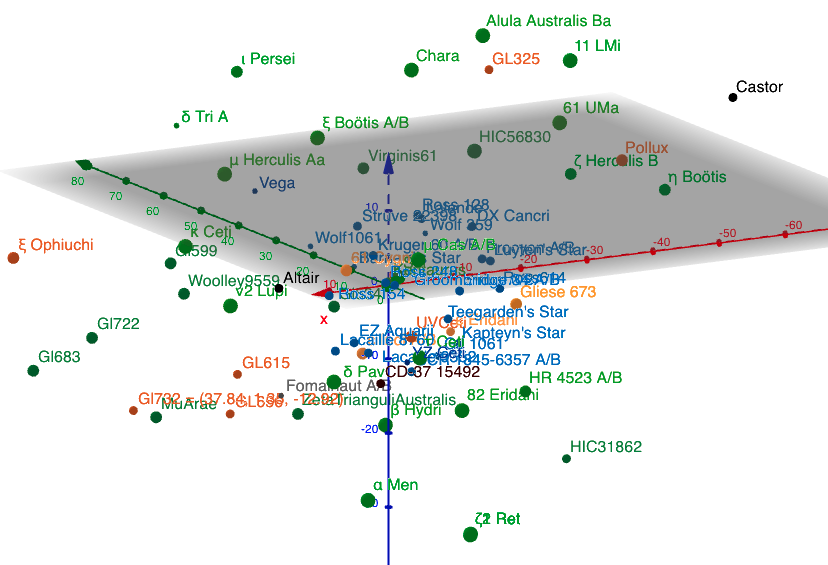
Science Fiction Fandom at a Brew Pub
Had a wonderfully exciting conversation last night at a brew pub with three incredible fans of Trek and Wars. We talked about how people like Trek for its trekkiness and Star Wars for its camp, and some people really screwed up when they tried to make Trek more like Wars. We talked about how the Enterprise, far more than even Kirk, is the face of Trek. The Enterprise is a character in the franchise that people love, and the first time it was destroyed on-screen, people cried. But it was a huge mistake to then destroy the ship in every subsequent film.
Note to Directors: You have to let a character build a relationship with the audience before you kill it off for shock value. So put a moratorium on killing the Enterprise for a while.
As a subset of this conversation, we talked about one of the major differences between Trek and Wars. I feel compelled to point out that nobody in the conversation ever once said that one is better than the other. We all like both Trek and Wars. (This is allowed. I checked.) But if you refuse to acknowledge the differences, then you’re missing the point.
One such difference is how the two franchises treated the concept of fascism. The message from Wars: Fascism is bad, even if you have to fight it with religious fanaticism. We compared this to the TOS episode, Patterns of Force which discussed fascism not only in historical context but how it can come about even with the best of anti-fascist intentions.
How to find the last occurrence of a value in Apple’s Numbers spreadsheet
I know what you want to ask: Why are you using Numbers when Excel is so much better and more versatile? Excellent question! I ask myself that all the time.
There are many things you can do with Excel that can’t be done in Numbers, and it often seems like I find a new one every day. Let’s face it, Numbers isn’t intended for the same users as Excel.
That being said, I don’t like Excel and I don’t even have a good reason for it. Maybe it’s a natural aversion to monopolies or something. Maybe it’s dedication to a brand – I’ve been a loyal Apple user since the days of the Apple ][. Well, maybe not that loyal. I don’t like iPhones or iPads. But you should ask me about iGlasses sometime.
Regardless. I ran into a problem while creating a spreadsheet in Numbers. I was about to relent and create it in Excel when I ran into a similar problem.
How to Return the Last Occurrence of a Value from a List of Values. Here’s my problem in detail:

The Practice Items column is a list of the songs I’m currently practicing on the piano, and I want to keep track of how much time I spent practicing that piece and when I practiced it. The column in question is Last Practiced. I want a polite warning if I haven’t practiced a piece in a while.
The problem was getting that column to return the Last Time I Practiced It. For instance, I practiced Adele’s Someone Like You on April 4 and April 5, and I want April 5 to show up in the last column.
After messing around with Numbers for longer than I really should have, or longer than the problem really merited, I tried to do the same thing in Excel. To no avail. I was starting to feel really stupid.
So I googled the problem and found that different authors had presented three different ways to do it in Excel. And none of them will work in Numbers.
I was about to give up and use an Excel spreadsheet when my stubborn streak kicked in. There HAS to be a way to do this! So I made another pot of coffee and dug into it.
I used the template from the Excel solutions and modified the elements of the equation that returned errors in Numbers. My stubborn patience was rewarded.
If you came here looking for this solution, here it is: Ta da!
This is from the Someone Like You cell: IF(ISERROR(VLOOKUP(G4,Practice Item,1,0)),””,INDEX(Practice Item:Date,MATCH(G4,Practice Item,1),2))
The important part is INDEX(Practice Item:Date, Match(G4,Practice Item,1),2).
The if-iserror statement is simply so that it won’t put the last date on the list for items that I haven’t practiced.
I hope somebody finds this useful.
